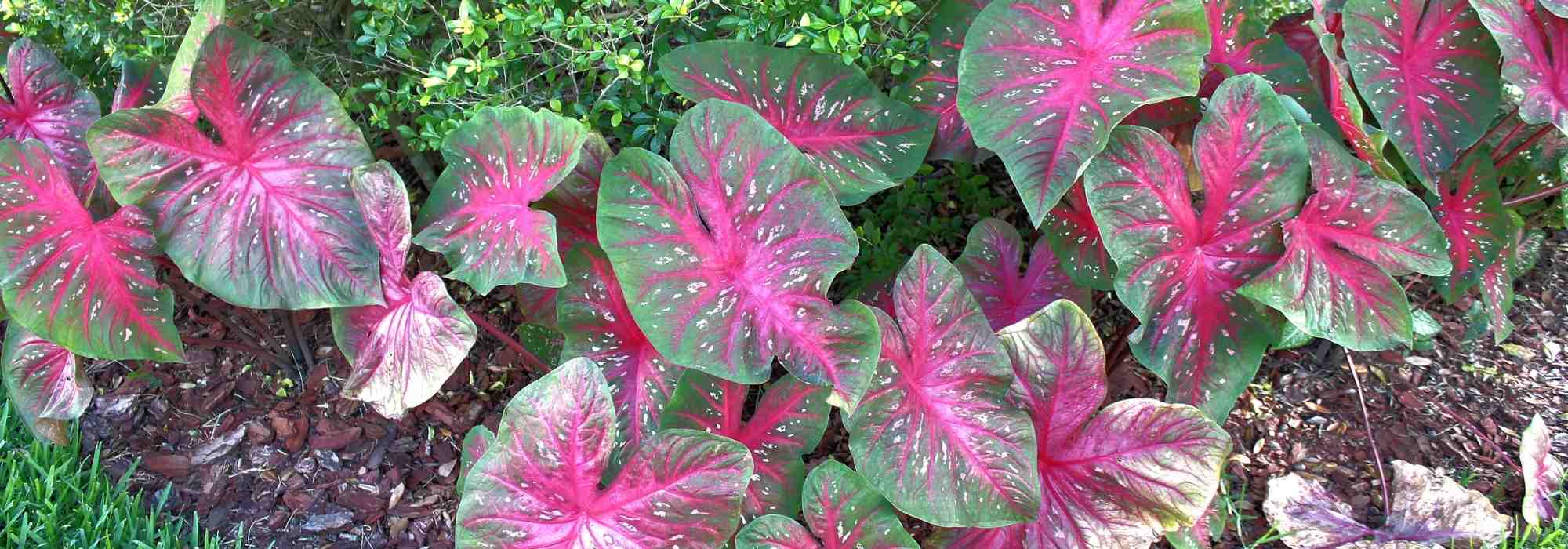
Caladium, Elephant ear: planting and growing
Contents
The Caladium in a few words
- Caladium is a perennial plant, not hardy in our climate
- This plant is grown for its colourful, heart-shaped leaves
- Caladium can be grown in the garden as an annual
- It can also thrive in pots to be stored in winter, or as a houseplant
- Caladium prefers partial shade and a rich, light substrate that remains moist
The word from our expert
The Caladium is a plant that undeniably brings a tropical presence to any indoor space. But not only that… Indeed, and this is less well-known, you can absolutely grow Caladium tubers outdoors and in the ground. However, in this case, either you treat Caladiums as annual plants, or you dig up the tubers before winter and store them in a dark, frost-free place. You can then replant them the following spring.
In any case, few plants boast such stunning foliage. The large elephant ear leaves of Caladium bicolor display incredible colours depending on the cultivar: green streaked, dotted, or splashed with white, cream, pink, and even red. The spathe-like flowering, so characteristic of the Araceae botanical family, is admittedly not very spectacular, but it is quickly forgiven given how the Caladium delights us from spring to autumn.
Not hardy, the Caladium or Elephant Ear is a plant native to the tropical forests of South America. It grows on the edges of these forests and along riverbanks. As you may have guessed, the Caladium needs light but never direct sunlight: partial shade will suit it perfectly. Additionally, the soil must be rich, light, and above all, remain moist all year round. If you provide these conditions, your Caladium will reward you with its stunning exotic foliage almost all year long.
Don’t hesitate to take the plunge: try growing Caladium tubers at home, in pots or, as annuals, in your garden. I assure you, they are truly worth it!
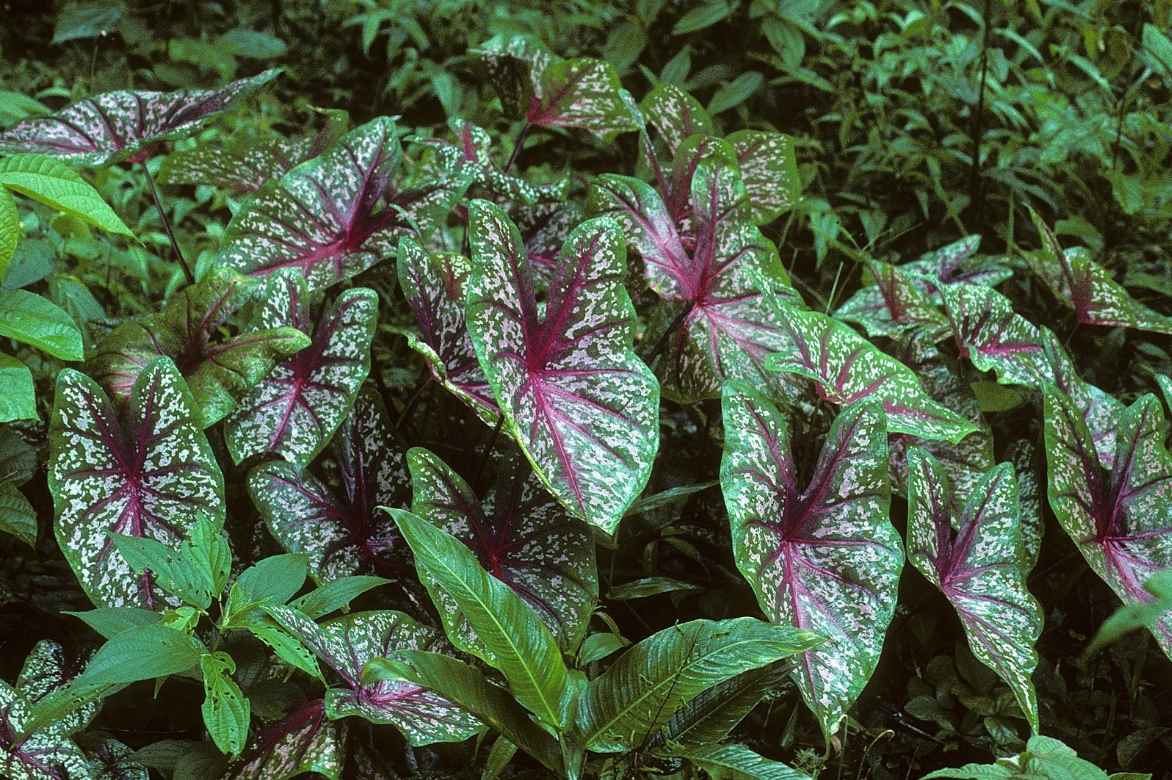
Caladiums, a tropical vibe at the end of your garden!
Botany and description
Botanical data
- Latin name Caladium sp.; Caladium bicolor
- Family Araceae
- Common name Caladium, Elephant Ear, Angel Wings, Heart of Jesus
- Flowering July-August
- Height 60 cm
- Exposure partial shade
- Soil type rich and light, moist
- Hardiness not hardy
Caladiums are plants from the Araceae family, like Arums or Anthuriums, for example. The genus Caladium includes 12 species distributed across South and Central America. There are many vernacular names: Caladium, Angel Wings, Heart of Jesus, and Elephant Ear (but be careful not to confuse the caladium with Alocasias and Colocasias in the latter case).
In their natural habitat, caladiums grow in clearings of tropical forests and along riverbanks. They therefore require moist soil and partial shade.
The most commonly cultivated species for ornamental purposes is Caladium bicolor, sometimes referred to as Caladium x hortulanem, with nearly 1000 cultivars. Caladium shomburgkii is also grown for ornamentation and has produced multiple varieties known as “spearhead” Caladiums due to the shape of their leaves.
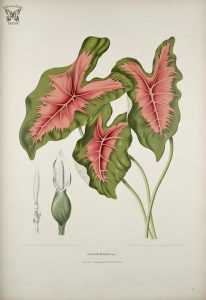
Caladium bicolor-botanical plate 1880
The plant is a tuberous perennial with a vegetative part reaching 40 cm to 60 cm in height and width, depending on the species and cultivars. The green foliage, often coloured with white, cream, pink, or red, features broad sagittate leaves, 15 cm wide and 45 cm long, shaped like a heart or rather an elephant’s ear. This foliage disappears completely during the dry season in its natural habitat and around October in our regions: the plant then enters its dormant phase.
Like all Araceae, the flower is a spathe (resembling a sort of “fry cone”) surrounding a green spadix, a cylindrical spike bearing numerous tiny flowers. The inflorescence is slender, greenish-white, and practically hidden beneath the foliage. The inflorescence is not particularly ornamental and weakens the tuber, so it can be removed without hesitation.
The caladium lives for 2 to 5 years under optimal growing conditions: in a greenhouse or conservatory.
All parts of the plant are toxic if ingested and may irritate sensitive skin. The plant is not lethal to dogs and cats, but caution is still advised for our four-legged friends.
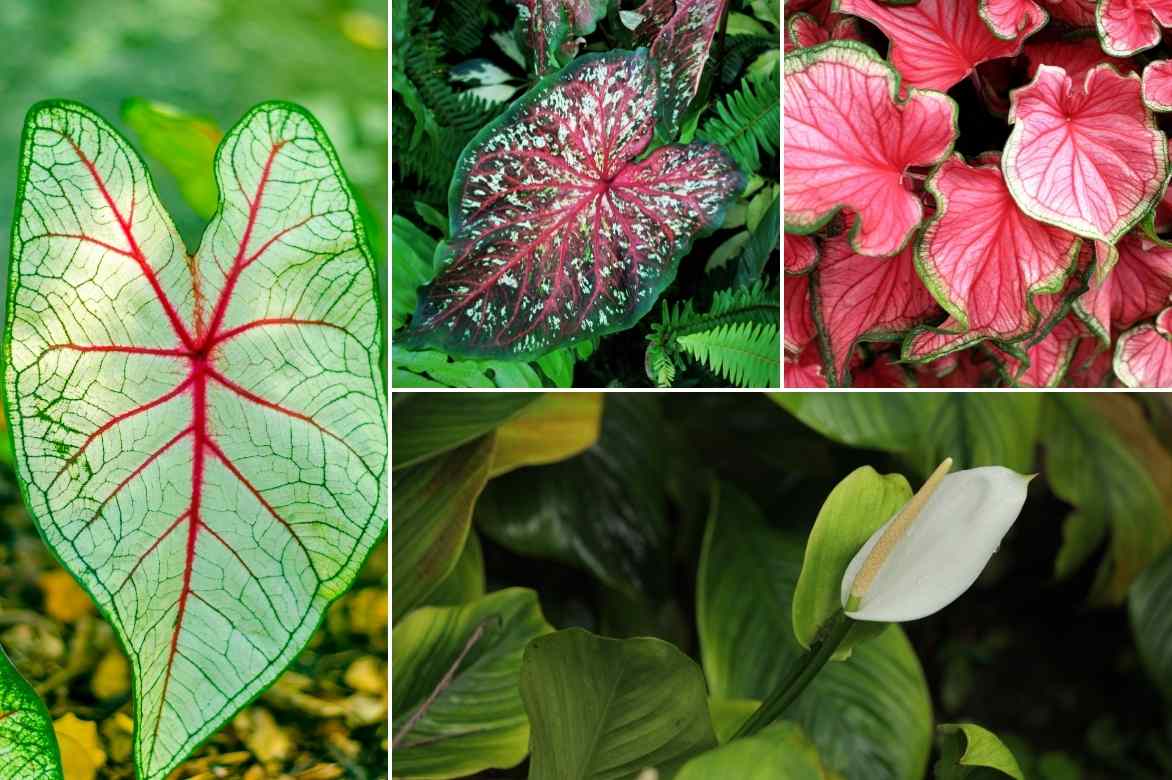
Caladiums offer incredible colour variations. Bottom right: the spathe flower.
The most beautiful varieties
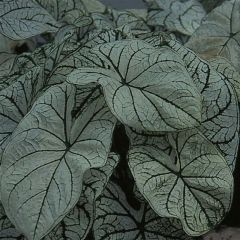
Caladium bicolor Candidum - Angel Wings
- Height at maturity 60 cm
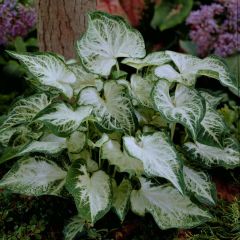
Caladium Aaron - Angel Wings
- Height at maturity 50 cm
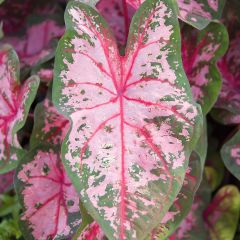
Caladium Carolyn Whorton - Angel Wings
- Height at maturity 60 cm
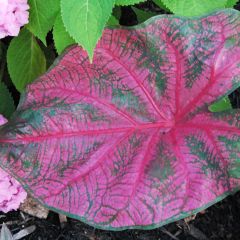
Caladium Fannie Munson - Angel Wings
- Height at maturity 50 cm
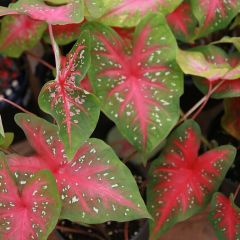
Caladium Red Flash - Angel Wings
- Height at maturity 60 cm
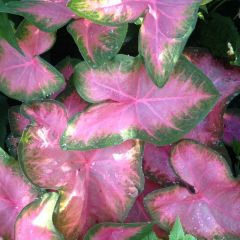
Caladium Rosebud - Angel Wings
- Height at maturity 55 cm
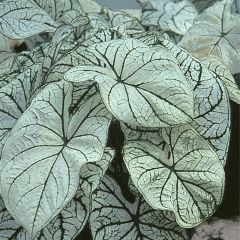
Caladium White Christmas - Angel Wings
- Height at maturity 60 cm
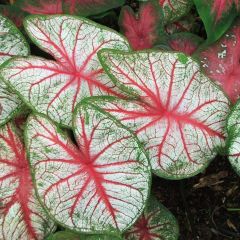
Caladium White Queen - Angel Wings
- Height at maturity 60 cm
Discover other Caladium
View all →Available in 1 sizes
Available in 1 sizes
Available in 1 sizes
Available in 1 sizes
Available in 1 sizes
Available in 1 sizes
Available in 1 sizes
Available in 1 sizes
Available in 1 sizes
Available in 1 sizes
Planting Caladium
Where to Plant?
The soil or substrate should be rich, acidophilous, and moist. Caladiums dislike heavy, poorly drained soils, as well as dry soils.
Caladiums are tropical plants that require temperatures between 20 and 25°C (15°C being the minimum survival temperature). These plants are therefore best suited for cultivation in a heated greenhouse, conservatory, or indoors, provided sufficient humidity is maintained. However, they can also be attempted outdoors after the last frost. In the latter case, caladiums are typically grown as annual plants.
Caladiums require partial shade outdoors or gentle light indoors. Indoors, place your caladium in a well-lit spot, but not behind a south-facing window, as direct sunlight can scorch the foliage. In the garden, plant your caladium in partial shade under trees.
Avoid placing your caladium near a heat source, such as a radiator, as this plant thrives in high ambient humidity.
Also, protect it from drafts and dry air, which tend to cause the foliage to curl, whether indoors or outdoors.
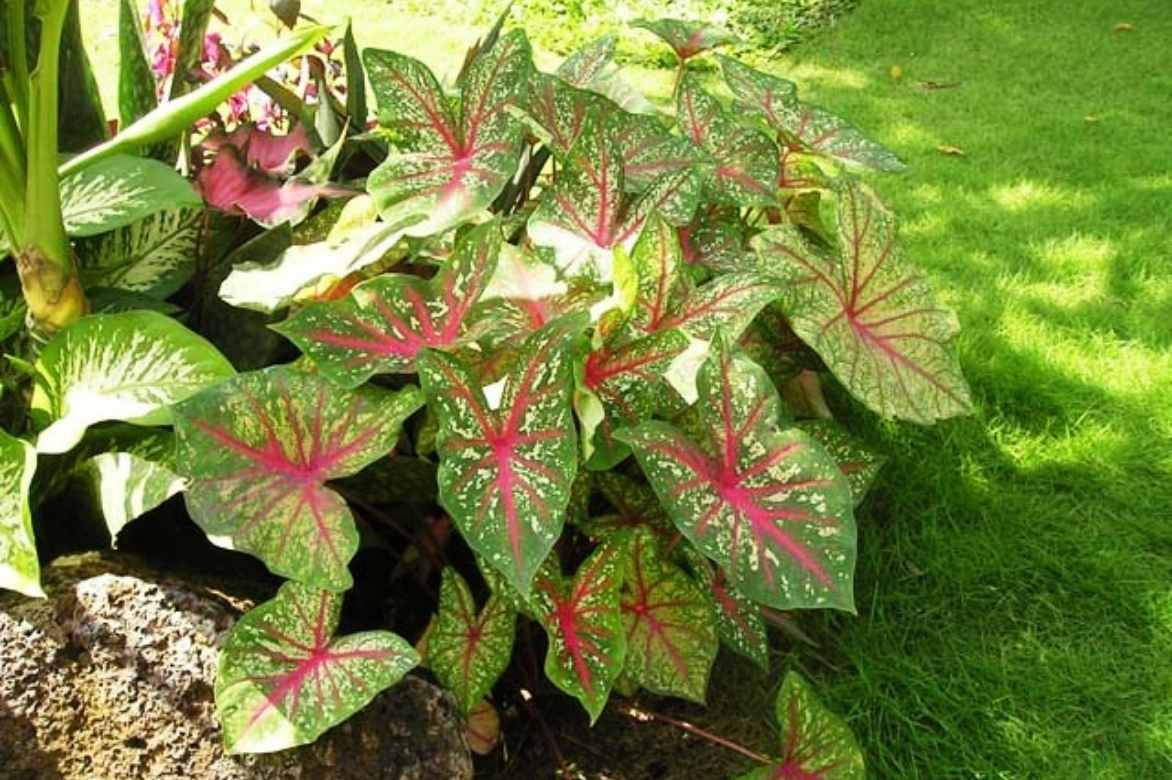
Caladium bicolor (© VanLap Hoàng)
When to Plant?
Plant your Caladium tubers outdoors or in pots after the last frost: March-April, depending on your climate.
How to Plant?
Outdoors
Planting outdoors should be done in partial shade, in humus-bearing soil, and after the last spring frosts.
- Loosen the soil to a depth of a few centimetres: add some compost if you deem it necessary;
- Plant your caladium tubers, spacing them about 30 cm apart: the bud of the tuber should face upwards, and cover it with 3-4 cm of soil;
- Water thoroughly to moisten the soil around the tuber(s).
In Pots
A plastic pot can be a good option, as this material retains moisture well. However, terracotta pots are more durable and porous: they prevent excess water retention. In any case, choose a pot with drainage holes at the bottom.
→ For small caladium “bulbs”: a 10 cm diameter pot will suffice.
→ For larger “bulbs” or for repotting every two years: a 15 to 20 cm diameter pot will be perfect.
- Place clay pebbles, gravel, or simple pottery shards at the bottom of the pot. This will further improve drainage;
- Fill with the appropriate substrate: a potting mix for houseplants or indoor plants works very well. You can also try mixtures like: 1/3 universal potting mix, 1/3 river sand, and 1/3 heather soil;
- Place your caladium tuber in the centre of the pot and bury it about 2 cm deep;
- Fill the rest of the pot with the potting mix and lightly press down with your fingers;
- Water well to moisten the substrate and eliminate any air pockets in the soil;
- Use a saucer under your pot to catch excess water. This saucer can also be filled with clay pebbles or small gravel to retain some moisture.
If necessary, in the case of a pot that is too small, repotting should be done in early spring, i.e., March-April.
→ Learn more about growing Caladium in pots and How to plant a Caladium bulb in our advice sheets.
Maintaining a Caladium
In the Ground
- Water occasionally, especially in summer, to prevent the soil from drying out;
- If you wish to keep your caladiums year after year: dig up the tubercles before the first frosts, in October when the foliage has dried, then store them in a little turf or sand, in a dry, cool place (15 to 18°C) and in the dark during winter.
In a Pot
- From March to October: keep the compost slightly moist at all times, without overwatering. Regularly mist the foliage with non-calcareous water (rainwater) at room temperature. You can apply a liquid fertiliser for green plants every two weeks or so;
- From 15 June to 15 September: you can move your potted caladium outdoors or onto the terrace if the temperature is sufficiently high (at least 15°C);
- October-November: stop watering. The leaves of your caladium will turn yellow and then dry out. You can remove them at this stage;
- November-March: place your tubercles in a dry, dark, and cool spot;
- March-April: start watering the substrate again to encourage your caladium to regrow.
Note: flowering may occur at the end of summer. This is not very attractive and exhausts the plant. You can cut back the flower spikes if you wish.
Reminder: Caution, all parts of the plant are toxic: handle your caladium with gloves!
Discover everything you need to know about caring for your Caladium indoors throughout the seasons in our advice sheet.
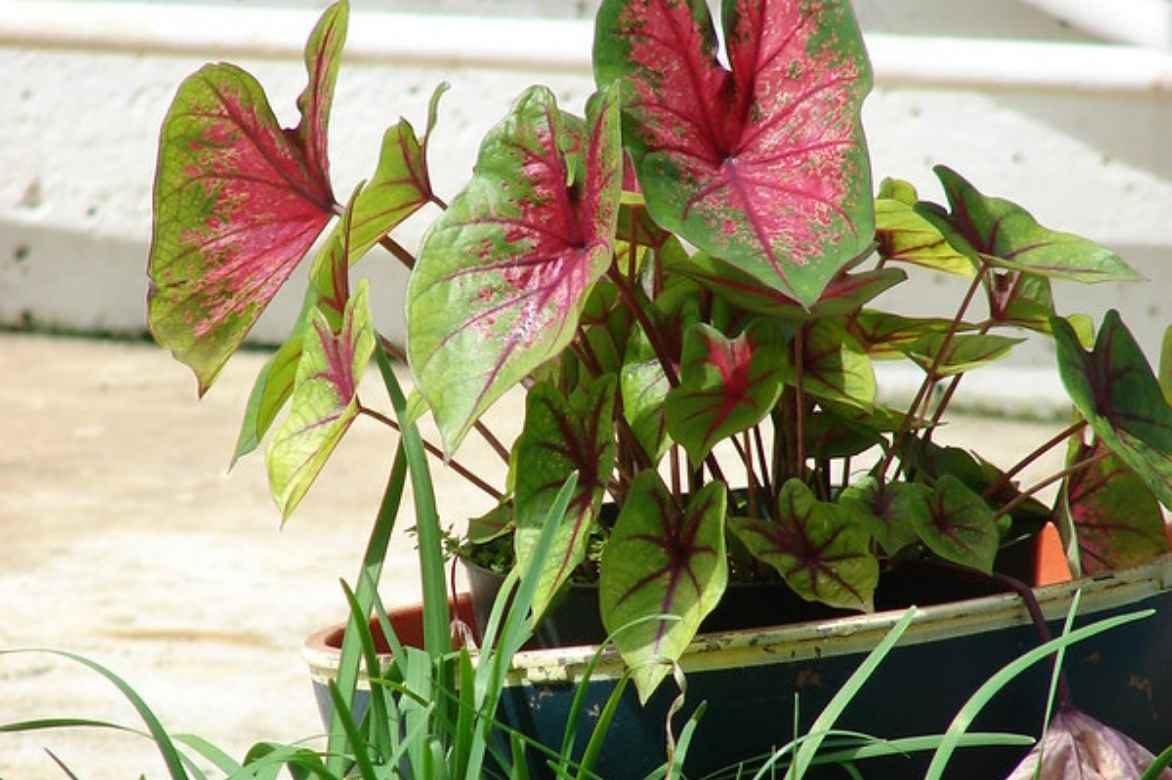
Caladium bicolor planted in a pot (© Forest and Kim Starr)
Diseases and Pests
Potted caladium is susceptible to common houseplant diseases. It is not uncommon to find scale insects, aphids, or spider mites.
→ In case of a scale insect infestation, follow Virginie’s expert advice on the subject: Scale Insects: Natural Treatments.
→ A spider mite attack on your caladiums? Don’t panic, follow François’ treatment advice: Spider Mites: Natural Treatments.
In the ground, young shoots of caladium attract slugs and snails. Caution is therefore advised in early spring. Aphids may also appear on your outdoor plants: no need to worry, however, as predatory insects (ladybirds, hoverfly larvae…) and parasitoids (Aphidius) in the garden will quickly resolve the issue.
→ To learn more, read our article: “Diseases and Parasites of Indoor Caladium: Identify and Protect Your Plant“.
Propagation of caladium
To propagate your caladium, you can detach between March and April the small tubercles that have formed around the main tubercle.
You can then plant these “baby caladiums” in pots to let them grow for a year and then either keep them in pots (in which case, you will repot them into a larger pot) or plant them in the ground the following spring.
How to pair caladiums?
Dream of Travel in Your Living Room or Office
Indoors, you can place your caladium alongside other tropical plants. Ideally, pair it with houseplants native to the same geographical region or even the same botanical family: Monstera deliciosa, Anthurium digitatum, Dieffenbachia seguine… You could also add an Asian companion: Alocasia macrorrhizos or Elephant Ear. That way, if you shout “Elephant Ear?” at home, two plants will answer you.
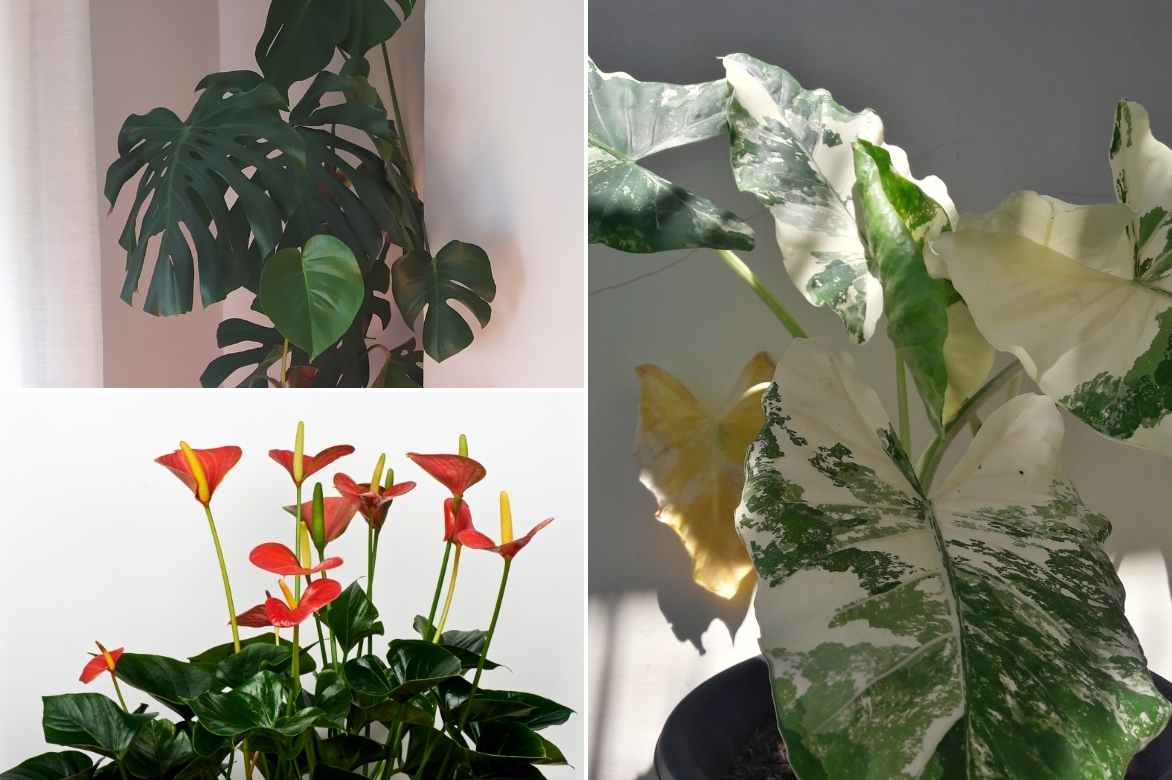
Caladium on the right, alongside Monstera deliciosa and Anthurium digitatum
Tropical Vibes on Your Terrace
Fancy sipping coffee or tea in a tropical setting? A few potted caladiums will add a splash of colour with their foliage to a terrace, balcony, or small courtyard. Pair them with a Dipladenia or Brazilian Jasmine. A stunning Agave attenuata not only offers beautiful rosette foliage but also blooms annually, unlike other agaves. Cordylines can thrive in pots for years, such as the Cordyline ‘Charly Boy’, whose red hues will perfectly complement the red tones of certain caladiums (Caladium ‘Red Flash’).
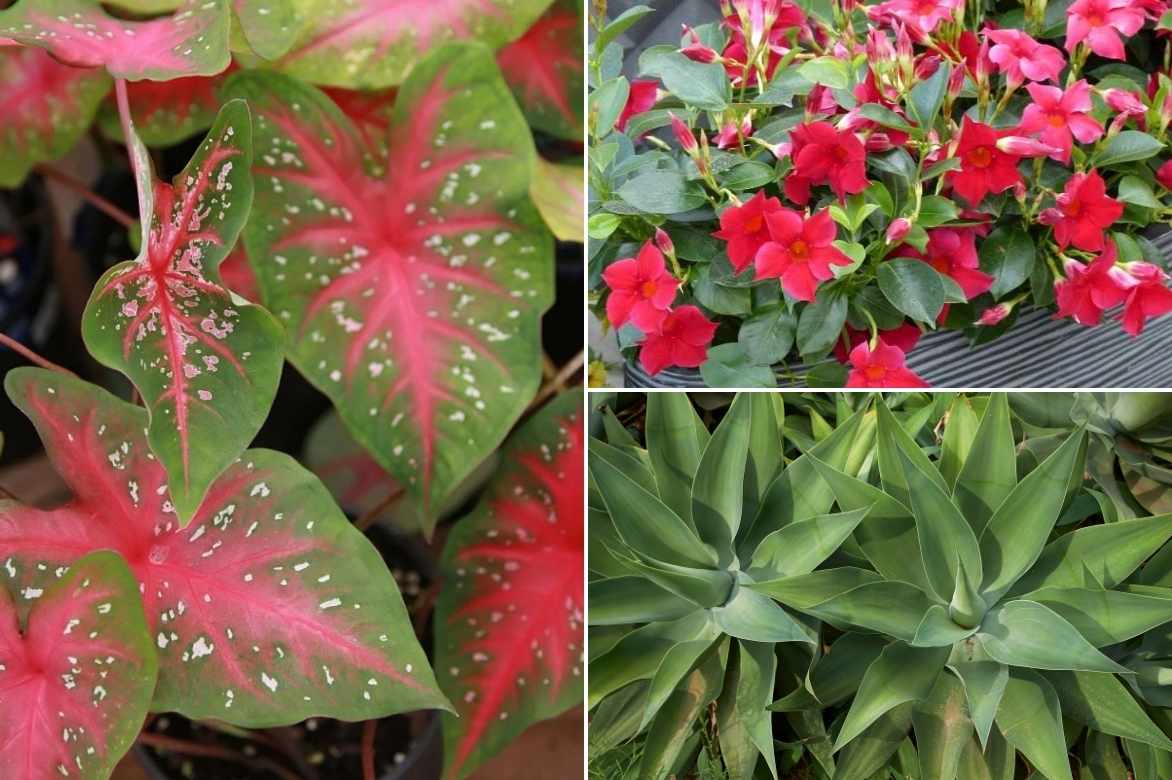
Caladium ‘Red Flash’, Dipladenia, and Agave attenuata
A Mini Jungle in Your Garden
If you consider the caladium as an annual, you can certainly grow it in your garden in open ground. In this case, place it in a cool, shaded woodland area, sheltered from direct sunlight and drafts. Pair it with other subtropical plants like a Tree Fern (Dicksonia antarctica), a Schefflera delavayi, a cousin of our indoor scheffleras, and a classic but always effective Fatsia japonica. Not very hardy but spectacular, the Abyssinian Red Banana makes a striking impact in just one season. However, keep it in a pot to protect it from frost before winter. To echo the “elephant ear” foliage of caladiums, consider colocasias like Colocasia esculenta ‘Black Magic’. Ferns of all kinds are always welcome in shaded garden areas, but why not try a more exotic (and slightly tender!) fern like Blechnum brasiliense ‘Volcano’, a Brazilian fern with young fronds in red-purple.
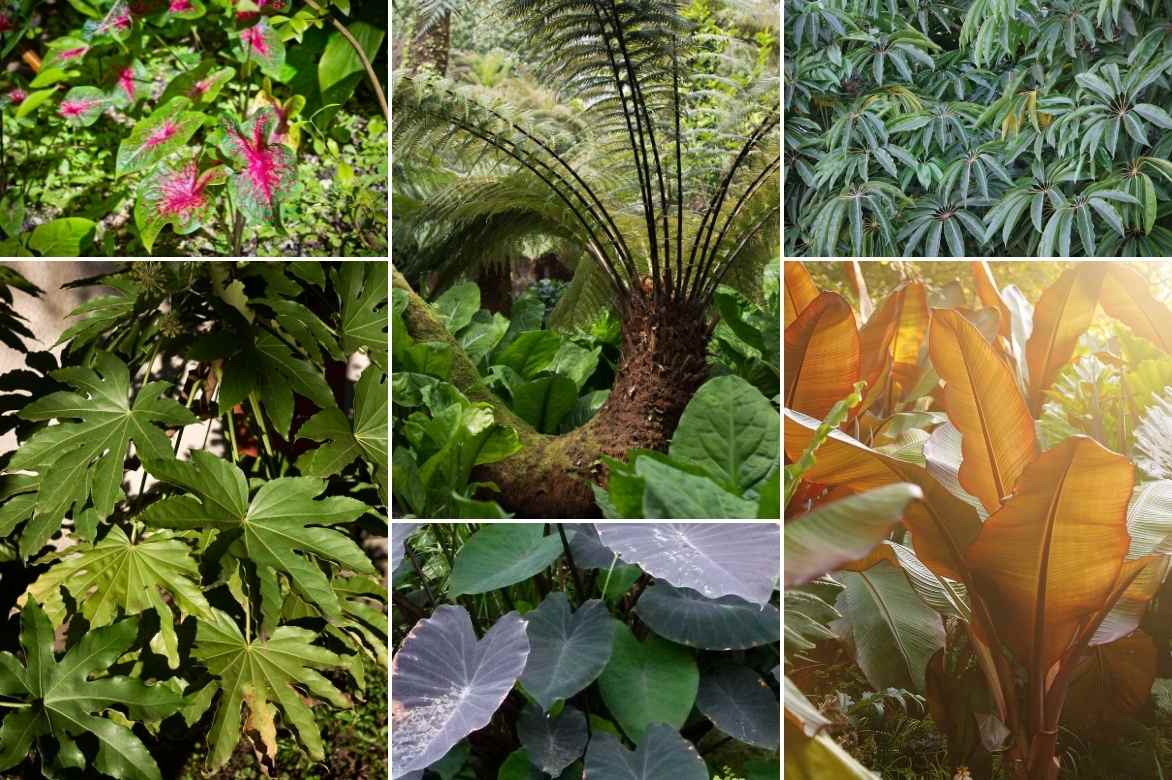
Caladium bicolor, Fatsia japonica, Dicksonia antarctica, Colocasia esculenta ‘Black Magic’, Schefflera taiwaniana, and Abyssinian Red Banana
→ Discover more beautiful pairings with Caladium in our advice guide!
Did you know?
- The genus Caladium derives its name from the Amerindian word “kélady“, the name of this plant in the local dialect;
- Caladiums have been cultivated in Europe since the late 18th century.
Also worth reading
→ Discover a beautiful selection of Caladium in our online nursery.
→ To learn everything about growing Caladium in pots, read “Growing a Caladium in a Pot”.
→ If you have any questions or concerns about planting Caladiums, our article “Planting a Caladium Bulb” will provide you with everything you need to know.
- Subscribe!
- Contents
































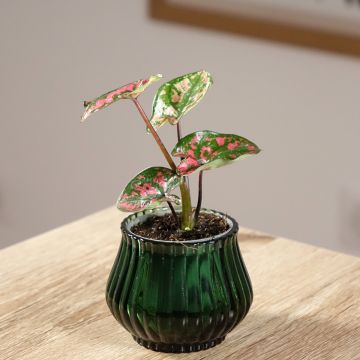








Comments